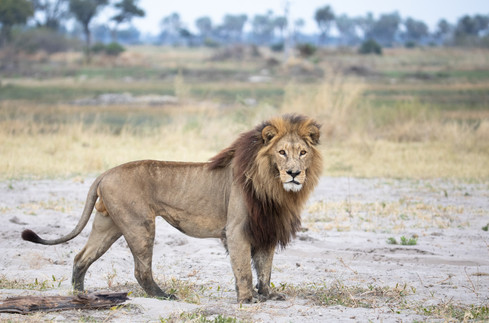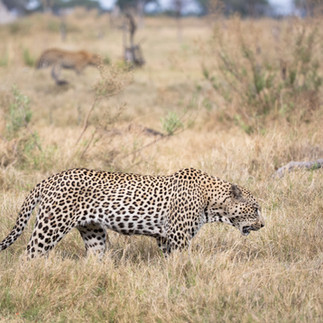Kings of the Kalahari
- NHFU
- Sep 7, 2022
- 4 min read
Growing up as a king in the Kalahari isn’t quite as glamorous as it sounds. Unlike the British royal family, or the Lion King, big cats aren’t born kings – they must instead fight for the right to become one. These fights are often bloody and brutal, and sometimes even to the death. But it’s worth it. Being king gives you prime access to mates and, most importantly, it allows you to pass on your genes to a new generation. Because of that, the first act of any new king is more often than not to kill the still vulnerable young of their predecessor. While a mother is still lactating, her reproductive abilities are suppressed. With no cubs relying on her milk, she is free to have a new set that is fathered by her new king.
Growing up as a young lion isn’t easy. Injuries, starvation, illness, and infanticide are all too common events in the African bush, meaning that just 67% of lion cubs survive to adulthood. Surviving the first years is hard, but if you’re a male, at adolescence it doesn’t get any easier. As soon as young males start to reach sexual maturity, at around two years old, they represent a direct threat to their (presumably) father. While the females remain within the protection of the pride, the males are cast out to fend for themselves.
These young, vagrant lions roam vast distances alone or as part of a small band of brothers (or cousins!). Everywhere they go, they represent a threat to the establishment and are bruised, beaten, or killed for their troubles. This is the most dangerous time to be a male lion, not least because as they venture further from home in search of a new one, they often encounter human settlements and the easy, domesticated prey that comes with it. The longer they can survive, the bigger, stronger, and better fighters they become. Only the luckiest make it and usurp the crown of an established rival to claim their own.
Making it to adolescence for a cheetah cub is even harder. Litter sizes range from one to eight cubs, but mortality can be as high as 90%, particularly in areas where other predators are abundant. Cheetahs sit at the bottom of the pecking order of the big cats, and their cubs are vulnerable to predation by leopards and lions (although they have been known to turn the tables on their head!). However, small cubs do have a trick up their sleeves. It is thought that the fluffy, silvery-grey mantles that run down their backs have evolved to mimic the fearsome honey badger, thus deterring predators like lions and eagles from attempting to kill them.

At around three months old, this mantle disappears and they start to move around with their mother, even joining in hunts from around one year of age. By 18-months, they separate. Male brothers will stick together for the rest of their lives, forming a ‘coalition’, whereas brothers with sisters will soon be driven away by rival males. Like lions, they’ll roam until they can find and defend a territory, usurping the current king(s) in a journey that can sometimes be hundreds of miles long. These fights can be deadly and are the reason that male cheetahs have an average lifespan of just 8 years, in comparison to females who can live 10-12.
Leopard cub survival rate is highly dependent on their environment. In some cases, 35% will not reach adulthood, meanwhile, in areas of high human conflict, 90% will never reach adulthood. On average, only around 37% do make it. While leopard cubs can be predated upon by a range of predators, including other big cats, they are pretty savvy from a young age and can use their arboreal abilities to evade capture. That being said, one of the most heartbreaking moments of the Natural History Film Unit’s history, had to be during the making of Savage Kingdom season 1, when Matsumi, lioness queen of the Marsh Pride, killed one of Saba’s cubs. Season 2 followed the life of her surviving cub, Neo, into adulthood.
Other than the threat of lions, it is estimated that around 40% of all leopard cub deaths can be attributed to males. As discussed before, this is a way of ensuring they get their own genes into the mix, but females have a handy trick up their sleeves – by mating with as many males as possible, she leaves them unsure about paternity and they won’t risk killing her cubs if they could be his. The most dangerous time to be a leopard is as a youngster when they are blind and vulnerable, but the risk of an untimely death decreases with age. At sexual maturity, the dominant male leopard will chase the male cub out of his territory and he will have to roam in search of his own, where he will reign over a number of smaller, female territories if he can win the crown. This might sound brutal, but it’s really nature’s own defence mechanism against inbreeding.
The kings of the Kalahari have to fight hard enough for their crowns without human interference. It has never been more important that these wild animals are given the space to roam freely and naturally. The protection of huge areas of land for photographic tourism, like the Okavango, sets an example to the rest of the world. Tourism is the economic justification, if ever one was needed, for its continued preservation. Want to do your bit for conservation? Visit us in Botswana and see its kings for yourself. Not so bad, huh?











































Comments